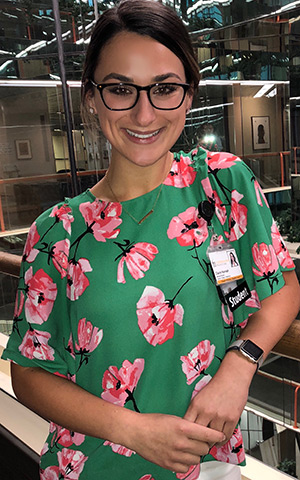Licensing exam success yields $3,000 scholarship
Claire Hannah, who begins her fourth year as an MD student, achieved the highest score among the most recent group of Carver College of Medicine students taking the USMLE Step 1.

Her score of 268 (out of a theoretical maximum of 300) garnered the Kansas City native a $3,000 scholarship award from the college to be applied toward medical school tuition and fees.
Since taking the USMLE Step 1 in January 2018, Hannah also has achieved an outstanding score on the USMLE Step 2, which tests clinical knowledge and clinical skills.
Hannah offers insight to her USMLE success and looks ahead to her future as a physician.
How did you prepare for the USMLE Step 1, and what was your experience taking this important exam?
The college’s curriculum schedule provides several weeks, in addition to the winter holiday break, for students to prepare to take the Step 1 exam in January. So, I had like four to six weeks to focus solely on the exam. As for the test itself ... it’s long. You get one hour of break time, so you can split it up over the course of the exam period. For me, the main thing was to just stay in the moment and take it one question at a time.
Were you surprised at how well you performed on the exam? And to what do you attribute your success?
It’s worth noting that I didn’t do incredibly well on the MCAT (Medical College Admission Test), so it’s not like I’m an amazing standardized test-taker. What helped me is that I simply find the material so interesting. That’s one thing I’d share with anyone interested in medical school: Make sure you’re choosing it for the right reasons. There is so much to learn, and the only way to stay motivated is to have a real passion for it. I love medical school. Right now is the favorite time of my life.
When did you know you wanted to become a physician?
I’ve always been interested in science. My mom earned an MD degree but chose to be a stay-at-home mom. My father was a radiologist. Growing up, I had a lot of exposure to medicine and science. I was always drawn to it—especially infectious diseases, which was the thing I’d always been super interested in. And then my father was diagnosed with brain cancer and passed away from it. That was around eighth grade. That experience exposed me even more to health care and hospital settings.
Before that, I’d never really experienced illness on such a personal level. That motivated me even more. I studied neuroscience as an undergraduate at Trinity College in San Antonio.
Since I’ve become a med student, I’ve found other interests, too. Dermatology is what I’ve decided on in terms of residency. I was always interested in infectious diseases, and cancer/oncology. I’ve found that dermatology incorporates a lot of components of both of those two. I’m looking forward to applying for residencies this fall.
Were you aware of how well you’d performed on the USMLE Step 1 in comparison to your fellow students taking the exam?
Not at all. I was invited to meet Dean (Brooks) Jackson in recognition of my “success,” but I wasn’t exactly sure what that meant. It was a pleasant surprise to learn I’d done so well (on the USMLE Step 1). Learning about the scholarship award was extremely nice, too.
And you also did very well the USMLE Step 2.
Yes. You can take Step 2 anytime during the year, before December, after you complete Step 1. So, I decided to take it right away because I figured some of my knowledge from Step 1 might carry over. I felt like I was on a roll.
Any advice for medical students who have yet to take the USMLE Step 1?
I’d say stay engaged in your classroom studies and clinical rotations. That’s what helped me the most. I think a lot of students think too much about the test itself and are not as focused on the rotation they’re doing at the moment.
With so much material that’s in the test, the only way you’re going to absorb all those details is to experience a real patient with a real disease. If you really get into that aspect, that patient will stick in your mind and help inform your understanding. You’ll find that you don’t need to memorize as much—I mean, you do, but you don’t, really. I just tried to stay as engaged in my rotations as I could.
The other thing, and this is most important, is to take care of yourself while in med school. It can be tempting to pull all-nighters, skip exercise, and not spend time with family. Making time for me kept me sane and well-rested. I actually went back home to study for the Step 1—and also spend time with my family, my dogs, and my friends. Having that supportive atmosphere really helped me.
A note about the exam
Step 1 of the United States Medical Licensing Examination (USMLE) is no ordinary test.
As the first exam in the three-exam process for medical licensure in America, the USMLE Step 1 measures how well students can apply basic and foundational science concepts to clinical scenarios.
The USMLE Step 1 is one of the most important exams a medical student must pass, and it’s one of the toughest—an eight-hour session consisting of seven 60-minute blocks, with each block including as many as 44 multiple-choice questions. That’s a maximum of 308 questions over the seven-hour testing period.
MD students in the University of Iowa Carver College of Medicine take the USMLE Step 1 after completing their core clinical clerkships, which is typically midway through their third year.
Undoubtedly, for most students, the Step 1 exam is a major challenge on the road to becoming a doctor.